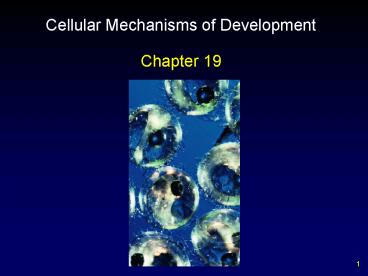Cellular Mechanisms of Development - PowerPoint PPT Presentation
1 / 28
Title:
Cellular Mechanisms of Development
Description:
nematodes - very simple design. 3. Vertebrate Development. Cleavage ... Nematode Development. Nematode Caenorhabditis elegans develops 959 somatic cells from a single ... – PowerPoint PPT presentation
Number of Views:485
Avg rating:5.0/5.0
Title: Cellular Mechanisms of Development
1
Cellular Mechanisms of Development
- Chapter 19
2
Overview of Development
- All three multicellular kingdoms exhibit cells
that express genes at different times. - mammals - complex bodies
- insects - intricate development cycle
- nematodes - very simple design
3
Vertebrate Development
- Cleavage
- Within an hour of fertilization, the zygote
divides rapidly into large number of blastomeres. - no increase in overall size
- two ends referred to as animal pole (form
external tissues) and vegetal pole (form internal
tissues) - cleavage slows after about 12 divisions, and
transcription of key genes begins
4
Cleavage Divisions
5
Vertebrate Development
- Formation of blastula
- water drawn into cell mass forming a hollow ball
of cells - blastula or blastocyst - Gastrulation
- some cells of blastula push inward, forming an
invaginated gastrula - invagination creates main axis of vertebrate body
- embryo now has three germ layers
- What are the 3 germ layers?
6
Vertebrate Development
- Neurulation
- zone of ectoderm thickens on dorsal surface of
embryo - neural tissue rolls and forms neural tube (brain
and central nervous system) - Cell migration
- variety of cells migrate to form distant tissues
(gonadal cells move through the embryo to
specific location to form sex organs somites
move to form skeletal muscles)
7
Vertebrate Development
8
Vertebrate Development
- Organogenesis
- basic body plan established
- tissues develop into organs
- embryo will grow to be a hundred times larger
9
Vertebrate Development
10
Insect Development
- Many insects produce two body types
- larvae - gathers food
- adult - capable of flight and reproduction
- Developmental stages
- larval instars
- three larval stages over four days
11
Insect Development
- Imaginal disks
- committed to form key parts of adult fly
- Metamorphosis
- larvae transformed into pupa
12
Insect Development
13
Nematode Development
- Nematode Caenorhabditis elegans develops 959
somatic cells from a single fertilized egg.
14
Cell Movement and Induction
- Cell movement
- Cells can move by pulling themselves along with
adhesion molecules. - Cell migration is largely a matter of changing
cell adhesion patterns. - Cadherins protein that connects cells
- Integrins fingerlike protein projections
- that help cell moves
15
Cell Movement and Induction
- Induction
- Occurs when a cell switches from one path to
another as a result of interaction with an
adjacent cell. - Experiments of removing cells from animal pole
(ectoderm) and one from vegetal pole (endoderm)
of blastocyst
16
Cell Movement and Induction
- Inducing cells secrete proteins that act as
intercellular signals. - In some cases, organizer cells produce diffusible
signal molecules (morphogens) that convey
positional information to other cells. - Is this another possible way of regenerating cell
tissue?
17
(No Transcript)
18
Determination
- Mammalian cells are totipotent - potentially
capable of expressing all their genes. - If separated, any cell can produce a normal
individual. This is where stem cell research
comes in. - If cells from two different eight-cell embryos
are combined, a normal individual results
(chimera).
19
(No Transcript)
20
Determination
- Mammalian cells begin to differentiate after the
eight-cell stage. - Determination is the commitment to a specialized
developmental path. (Ex. cells might be
determined as gastrointestinal cells.) - Differentiation is the cell specialization that
occurs at the end of the developmental path.
(This is where cells develop into stomach, etc.) - Determination is reversible.
- Given proper technique, fate of fully
differentiated cell can be altered.
21
Mechanism of Determination
- Positional labels - In a chick embryo, cells
become partially committed to a certain type of
tissue, but the position of the cell on a body
structure makes a difference as to what the
tissue will develop into. If a cell from the
thigh region of a chick embryo is implanted into
the tip of the wing area, the cell will
eventually form a toe at the tip of the wing!
22
Pattern Formation
- Within three hours after fertilization,
orchestrated cascade of gene activity produces
fly embryos basic body plan. - Gene activation depends on free diffusion of
morphogens through cellular spaces - Anterior/posterior axis and dorsal/ventral axis
are determined in this way.
23
Expression of Homeotic Genes
- After pattern formation has been established in
Drosophila, a series of homeotic genes determine
the forms these segments will take. - code for proteins that function as transcription
factors - Mutations in homeotic genes can cause normal body
parts in unusual places. - Homeotic genes have also been found in mice and
humans
24
Programmed Cell Death
- Apoptosis - process of cells shriveling,
shrinking, and dying in a preprogrammed timeframe - program regulated by gene activation
- humans
- bax genes encodes program
- oncogene bcl-2 represses program (important in
research being done on aging and Alzheimers
disease)
25
Programmed Cell Death
26
Theories of Aging
- Accumulated mutation hypothesis
- as they age, cells accumulate mutations
- Telomere depletion hypothesis
- telomeric regions shortened by repeated
replications
27
Theories of Aging
- Wear and tear hypothesis
- Over time, disruption, wear, and damage,
eventually erode cells ability to function
properly. - no inherent limit to aging
- Gene clock hypothesis
- genes regulate rate of aging
28
(No Transcript)































